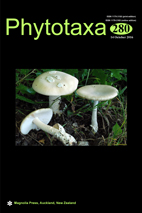Abstract
Ochrolechia kerguelensis Ertz & Kukwa is described as new to science from the subantarctic islands of Kerguelen. It is characterized by pruinose ascomata, usually 4-spored asci, large ascospores of 50–90 × 32–56 µm, the production of gyrophoric acid only in the apothecia and the lack of variolaric acid. A photobiont with cells containing orange guttules such as in trentepohlioid algae is recorded for the first time in the genus Ochrolechia, being present in O. austroamericana and O. kerguelensis. Ochrolechia antarctica is reinstated from the synonymy of O. parella and treated as a distinct species. Chemical and morphological differences between these taxa are discussed. Ochrolechia chilensis and O. deceptionis are treated as synonyms of O. antarctica. The phylogenetic placement of O. antarctica, O. austroamericana and O. kerguelensis is investigated using mtSSU rDNA sequences and a Bayesian analysis. A key to all fertile, saxicolous Ochrolechia species with a C+ red epihymenium occurring in the Southern Hemisphere is presented.

